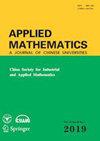Modeling and Numerical Solution of a Cancer Therapy Optimal Control Problem
IF 1
4区 数学
Applied Mathematics-A Journal of Chinese Universities Series B
Pub Date : 2018-08-14
DOI:10.4236/AM.2018.98067
引用次数: 5
Abstract
A mathematical optimal-control tumor therapy framework consisting of radio- and anti-angiogenesis control strategies that are included in a tumor growth model is investigated. The governing system, resulting from the combination of two well established models, represents the differential constraint of a non-smooth optimal control problem that aims at reducing the volume of the tumor while keeping the radio- and anti-angiogenesis chemical dosage to a minimum. Existence of optimal solutions is proved and necessary conditions are formulated in terms of the Pontryagin maximum principle. Based on this principle, a so-called sequential quadratic Hamiltonian (SQH) method is discussed and benchmarked with an “interior point optimizer—a mathematical programming language” (IPOPT-AMPL) algorithm. Results of numerical experiments are presented that successfully validate the SQH solution scheme. Further, it is shown how to choose the optimisation weights in order to obtain treatment functions that successfully reduce the tumor volume to zero.肿瘤治疗最优控制问题的建模与数值解
研究了肿瘤生长模型中包含的放射和抗血管生成控制策略的数学最优控制肿瘤治疗框架。该控制系统由两个完善的模型组合而成,代表了一个非光滑最优控制问题的微分约束,该问题旨在减少肿瘤的体积,同时将放射性和抗血管生成化学剂量保持在最低水平。利用庞特里亚金极大值原理,证明了最优解的存在性,并给出了最优解存在的必要条件。基于这一原理,讨论了所谓的顺序二次哈密顿(SQH)方法,并用“内点优化器-一种数学编程语言”(IPOPT-AMPL)算法进行了基准测试。数值实验结果成功地验证了SQH求解方案。此外,还展示了如何选择优化权重,以获得成功地将肿瘤体积减小到零的治疗函数。
本文章由计算机程序翻译,如有差异,请以英文原文为准。
求助全文
约1分钟内获得全文
求助全文
来源期刊

Applied Mathematics-A Journal of Chinese Universities Series B
MATHEMATICS, APPLIED-
自引率
10.00%
发文量
33
期刊介绍:
Applied Mathematics promotes the integration of mathematics with other scientific disciplines, expanding its fields of study and promoting the development of relevant interdisciplinary subjects.
The journal mainly publishes original research papers that apply mathematical concepts, theories and methods to other subjects such as physics, chemistry, biology, information science, energy, environmental science, economics, and finance. In addition, it also reports the latest developments and trends in which mathematics interacts with other disciplines. Readers include professors and students, professionals in applied mathematics, and engineers at research institutes and in industry.
Applied Mathematics - A Journal of Chinese Universities has been an English-language quarterly since 1993. The English edition, abbreviated as Series B, has different contents than this Chinese edition, Series A.
 求助内容:
求助内容: 应助结果提醒方式:
应助结果提醒方式:


